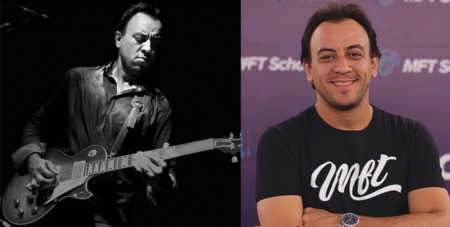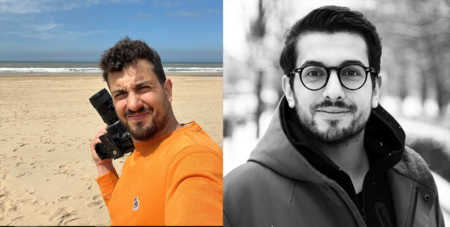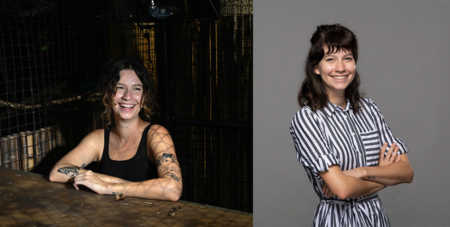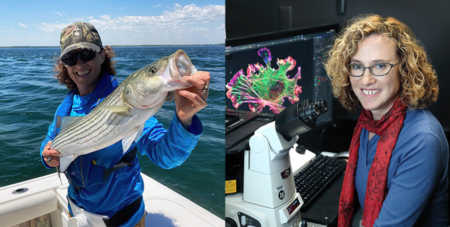In this article, you’ll meet the members of the 2022 judging panel who reviewed thousands of microscopy submissions from across the globe to select this year's winners.
Meet the JudgesMeet the Judges

Meet the 2022 Judging Panel
Nikon Small World showcases brilliant imagery and artistic feats in science, and the unseen world around us. With every new year, the Nikon Small World judging panel plays an integral role in selecting the images and videos that best blend science and artistry. Nikon strives to select a panel that exemplifies a range of expertise – a team that can evaluate a photo or video based on technical prowess, scientific significance, aesthetic appeal, and power to convey a story to the viewer.
Dr. Gustavo Menezes

Dr. Gustavo Menezes performing with his band, Banda Mr. Bison
Dr. Gustavo Menezes is no stranger to the microscope and the unseen worlds that exist around us. After being gifted a microscope at the age of five, Dr. Menezes has dedicated his life and career to in vivo imaging.
At what is considered the center for in vivo confocal microscopy in Brazil, Dr. Menezes serves as Associate Professor and Head of the Center for Gastrointestinal Biology at the Federal University of Minas Gerais. He dedicates his time to studying how immune cells exacerbate organ injury during acute liver failure utilizing in vivo imaging. “I have been interested in understanding leukocyte biology, specifically how leukocytes migrate to sites of cell death and how sterile inflammation damages tissues. During my master’s and Ph.D., I investigated mechanisms involved in leukocyte chemotaxis and started to work on the visualization of leukocyte trafficking in vivo.”
He is credited with establishing the first two-photon confocal microscope in Latin America to perform in vivo imaging, which has been widely used at the Federal University of Minas Gerais. With more than 15 years of in vivo imaging experience, Dr. Menezes provided an unparalleled perspective to this year’s judging panel.
“Science is for people. The only reason to study science is to ultimately benefit people. When combined with art, which is a universal language, I think that it is so powerful.”
When Dr. Menezes is not in his lab or selecting winning microscopy, he spends his time performing classic rock with his band, Banda Mr. Bison. You can learn more about the work of Dr. Menezes’ lab here.
Dr. Nikolay Nikolov

Dr. Nikolay Nikolov filming a documentary in
The Hague, Netherlands
For Dr. Nikolay Nikolov, art is a very powerful communication tool that can help contextualize and demystify the complexities of scientific discovery and jargon. Dr. Nikolov’s passion for visual storytelling and his desire to bridge the gap between the natural world and global audiences played a crucial role in selecting this year’s winning images.
Before joining The New York Times as a Senior Video Journalist, Dr. Nikolov led Mashable’s video team with a focus on technology and the environment. “We, as humans, perceive our world conceptually – we sort of understand how plants work and what cells tend to look like, but the images and videos that exhibit these unbending laws of nature are visual proof of the magic that is life. That proof of life bridges a gap between us and the microscopic, offering an emotional connection to that which we never even knew existed.”
Serving as a judge for this year’s competition was an absolute privilege for Dr. Nikolov. “My fellow judges and I were allowed to curate an enormous list of entries and the opportunity to select the most compelling work which was a very humbling and gratifying experience. I loved working with the other judges, I feel like our expertise was a perfect fit and I am astonished at the ease with which we reached consensus.”
When it comes to selecting winning microscopy, Dr. Nikolov says, “We often fall into the trap that the world is small, that we know everything there is to know, but what this competition shows is that we have barely even scratched the surface – there is a vibrant, colorful and oftentimes brutal world that exists all around us that we can now show with incredible accuracy and clarity. The world just needs to look closer.”
Annaliese Nurnberg

Annaliese Nurnberg staging a shoot at the Smithsonian
National Zoo for The Washington Post
Annaliese Nurnberg has had a deep appreciation for the natural world and the animals that inhabit it since childhood. Now serving as a Photo Editor at The Washington Post, she has brought her passion for the outside world to the stories that grace the pages of one of the leading daily American newspapers.
According to Nurnberg, “Science is important in so many ways, but especially when it comes to the future of our planet and the preservation of humanity. I think that blending it with art is a good way to capture the attention of those who might not typically seek out science stories. People love to look at beautiful things, and the story behind a stunning image can teach us so much.”
Visual storytelling and a keen eye for sparking curiosity in her readers have made her an invaluable asset to this year’s judging panel. “In photography, I always look for composition. I love interesting shapes and the use of color. Photographs that capture a “moment” or that tell a story are usually the most compelling. Videos should tell a story as well.”
When reflecting on this year’s in-person judging at the Marine Biological Lab in Woods Hole, Massachusetts, Nurnberg shares her appreciation for her fellow judges. “Our chemistry as a judging panel was pretty incredible. We had some great discussions about some of the images and worked well together as a team. It was also awesome just to be in Woods Hole and at the Marine Biological Lab. Learning about the research being done there was amazing, and I’ll always cherish my experience as a judge for Small World.”
You can find Nurnberg’s work here.
Dr. Clare Waterman

Dr. Clare Waterman on a recent fishing trip
Known for her work on understanding the role of the cytoskeleton in cell migration, Dr. Clare Waterman is regarded as a leading cell biologist in the scientific community. With more than 25 years of experience in imaging and microscopy, Dr. Waterman played a pivotal role in this year's judging panel – especially when it came to identifying difficult scientific techniques.
Like her scientist counterparts, Dr. Waterman’s career path wasn’t exactly linear. Passionate about fitness, she graduated from Mount Holyoke College with a B.A. in biochemistry in 1989, and received an M.S. in exercise science in 1991 from the University of Massachusetts. “I had this idea that I would be a strength trainer for elite athletes. But when I saw electron microscope images of muscle for the first time, I thought that it was the most amazing thing I had ever seen in my life and decided that I wanted to do cell biology and microscopy.”
With that in mind, Dr. Waterman received her Ph.D. in cell biology from the University of Pennsylvania in 1995. She spent 9 years as a professor in the Department of Cell Biology at the Scripps Research Institute in La Jolla, California. “I have always been interested in imaging living movement at the microscopic scale and that has been the focus of my career ever since.”
Dr. Waterman has had a great deal of experience when it comes to identifying visually compelling images and she was last a judge in 2017. “The submissions must have the fundamentals of good photography, such as being in focus, having a good composition and balanced color. I’m always looking for technical innovation and whether it reveals something that you see every day but in a way that you have never seen before. Microscopy does that in general and sometimes it is really shocking to see how ordinary things, such as bug mouths or dog hair, look when magnified 1000x.”
The competition, for Dr. Waterman, is something she is honored to participate in. “The thing I love about this contest is that it combines my two loves, art and science. It’s just a blast to see what kind of art people can produce in the medium that is my research tool.”
Like microscopy and cell biology, Dr. Waterman also shares a love for fishing in her free time.
Our judging panel this year selected some stunning microscopy, and the Nikon team is excited to share what they picked with the public in the months to come.
To stay up to date with the "Meet the Judges" series and receive your daily dose of Nikon Small World, follow us on Instagram, Twitter, and Facebook. Be sure to follow Nikon Instruments for the latest updates on equipment and technology.